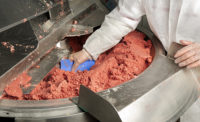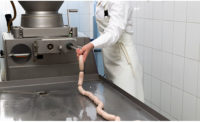Using science for better grinding and stuffing

Many of the challenges that processors face with grinding and stuffing is that raw materials vary widely. Those variations can have a big impact on grinding. Processors also have to be aware of how their grinding systems can handle foreign materials, such as bone and cartilage. For stuffing, challenges remain with achieving uniformity, and aligning the right equipment and correctly sized equipment versatility, says Jeff Sindelar, professor and extension meat specialist in the Department of Animal and Dairy Science at the University of Wisconsin, in Madison.
To combat these challenges, processors are trying to manage the raw materials and understand how the different raw materials create challenges in uniformity and consistency in grinding. They then try to identify these raw materials so they either are ground differently or are used in certain applications for specific products, Sindelar explains.
For example, understanding the raw material variability and challenges and then aligning that with the correct processes and equipment means processors need to make adjustments, such as with temperature. Based on the limitations of raw materials, processors also need to assess whether it can be ground on certain grinding equipment, whether it be the size of the plate, the speed of the grinding, or the configuration of the grinder itself. It’s the grinding equipment that best manages and handles the raw material variation in terms of quality and composition, Sindelar says.
“Grinding equipment and technology is about understanding the raw materials and applying meat science, food science, food safety, and engineering concepts to improve either equipment design or equipment capability and definitely the outcome of the process, whether it be grinding faster, grinding more efficiently, grinding to achieve a higher overall product quality or functionality,” he says.
For grinding, temperature rise during grinding also continues to be a concern, using traditional auger systems, in which the auger moves at the same speed as the blades. Another long-existing challenge with grinding is the need for bone removal systems, which increases the down-graded product or waste that results from the grinding process, says Lynn Knipe, associate professor in the Department of Animal Science at Ohio State University, in Columbus.
“The development of in-line grinder/stuffer units allow for controlling the blade and pump speeds independently, which reduces the friction on the meat, and as a result, the temperature rise to the meat,” he says.
Additionally, new technology is available to reduce the loss of soft tissue, which has historically been lost during the bone-separation process. “The discarded product from this new technology is truly waste material, being primarily bone and hard cartilage,” Knipe says.
A more current concern is with preventing oil leaks from gearboxes onto the product. This isn’t a new problem, but the emphasis to solve the problem has increased in recent years.
“Some equipment suppliers have separated their gearboxes from hoppers to eliminate the possibility of oil dripping from the gearboxes onto meat,” Knipe says. “Others have moved toward using electric motors to replace hydraulic systems typically used in meat processing equipment.”
As processors move toward using more automated processing equipment to assist with labor issues, the demand for labor switches to more technically trained people to operate and maintain this new equipment.
“This issue requires more highly trained employees both in the processing plants and in the equipment suppliers’ technical service divisions,” Knipe says.
As equipment becomes more automated and technologically advanced, maintaining the software also will be important to the grinding process, he adds. Knipe also expects equipment manufacturers to continue to modify their equipment in the future, to further resolve processing challenges.
Looking for a reprint of this article?
From high-res PDFs to custom plaques, order your copy today!









